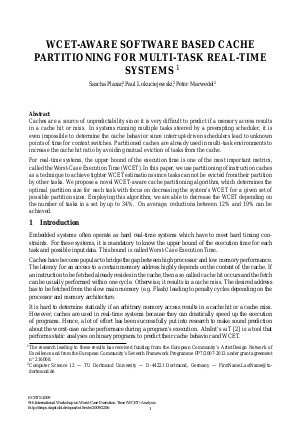WCET-aware Software Based Cache Partitioning for Multi-Task Real-Time Systems
Authors Sascha Plazar, Paul Lokuciejewski, Peter Marwedel
-
Part of:
Volume:
9th International Workshop on Worst-Case Execution Time Analysis (WCET'09) (WCET 2009)
Part of: Series: Open Access Series in Informatics (OASIcs)
Part of: Conference: Workshop on Worst-Case Execution Time Analysis (WCET) - License:
 Creative Commons Attribution-NonCommercial-NoDerivs 3.0 Unported license
Creative Commons Attribution-NonCommercial-NoDerivs 3.0 Unported license
- Publication Date: 2009-11-26
File

PDF
OASIcs.WCET.2009.2286.pdf
- Filesize: 138 kB
- 11 pages
Document Identifiers
Subject Classification
Keywords
- WCET analysis
- cache partitioning
Metrics
- Access Statistics
-
Total Accesses (updated on a weekly basis)
0Document
0Metadata
Abstract
Caches are a source of unpredictability since it is very difficult to predict if a memory access results in a cache hit or miss. In systems running multiple tasks steered by a preempting scheduler, it is even impossible to determine the cache behavior since interrupt-driven schedulers lead to unknown points of time for context switches. Partitioned caches are already used in multi-task environments to increase the cache hit ratio by avoiding mutual eviction of tasks from the cache. For real-time systems, the upper bound of the execution time is one of the most important metrics, called the Worst-Case Execution Time (WCET). In this paper, we use partitioning of instruction caches as a technique to achieve tighter WCET estimations since tasks can not be evicted from their partition by other tasks. We propose a novel WCET-aware cache partitioning algorithm, which determines the optimal partition size for each task with focus on decreasing the system's WCET for a given set of possible partition sizes. Employing this algorithm, we are able to decrease the WCET depending on the number of tasks in a set by up to 34%. On average, reductions between 12% and 19% can be achieved.
Cite As Get BibTex
Sascha Plazar, Paul Lokuciejewski, and Peter Marwedel. WCET-aware Software Based Cache Partitioning for Multi-Task Real-Time Systems. In 9th International Workshop on Worst-Case Execution Time Analysis (WCET'09). Open Access Series in Informatics (OASIcs), Volume 10, pp. 1-11, Schloss Dagstuhl – Leibniz-Zentrum für Informatik (2009)
https://doi.org/10.4230/OASIcs.WCET.2009.2286
BibTex
@InProceedings{plazar_et_al:OASIcs.WCET.2009.2286,
author = {Plazar, Sascha and Lokuciejewski, Paul and Marwedel, Peter},
title = {{WCET-aware Software Based Cache Partitioning for Multi-Task Real-Time Systems}},
booktitle = {9th International Workshop on Worst-Case Execution Time Analysis (WCET'09)},
pages = {1--11},
series = {Open Access Series in Informatics (OASIcs)},
ISBN = {978-3-939897-14-9},
ISSN = {2190-6807},
year = {2009},
volume = {10},
editor = {Holsti, Niklas},
publisher = {Schloss Dagstuhl -- Leibniz-Zentrum f{\"u}r Informatik},
address = {Dagstuhl, Germany},
URL = {https://drops.dagstuhl.de/entities/document/10.4230/OASIcs.WCET.2009.2286},
URN = {urn:nbn:de:0030-drops-22860},
doi = {10.4230/OASIcs.WCET.2009.2286},
annote = {Keywords: WCET analysis, cache partitioning}
}
